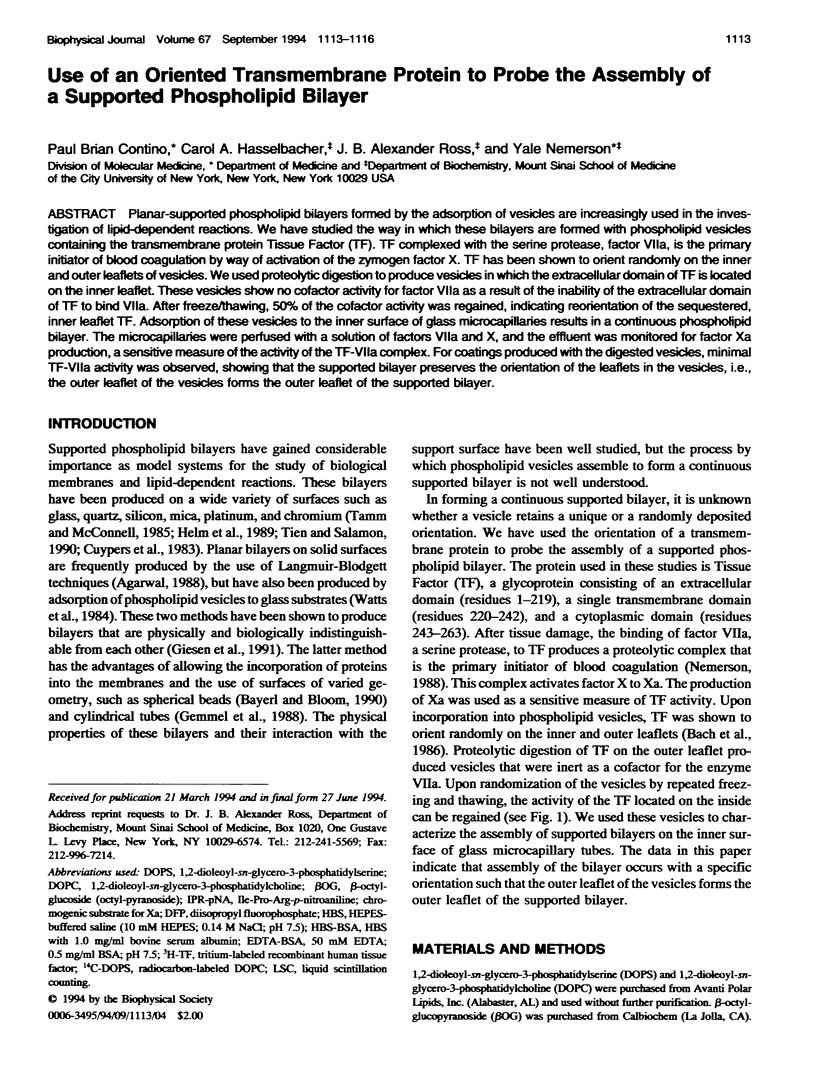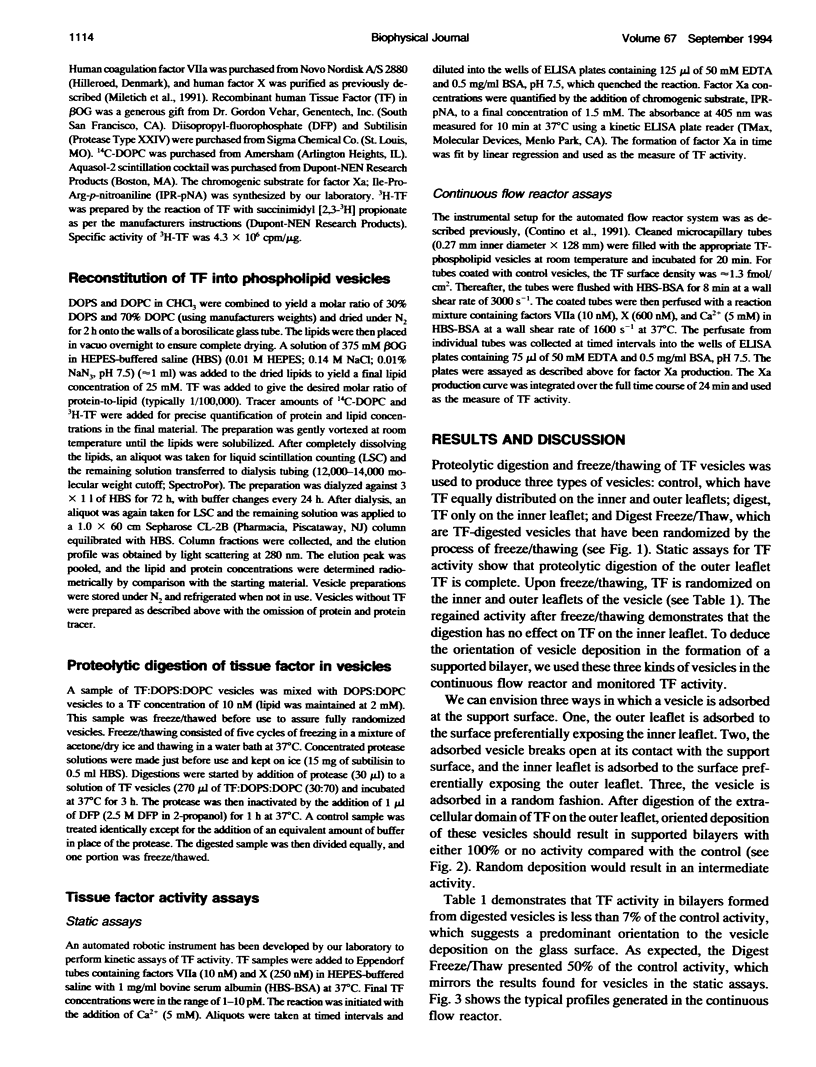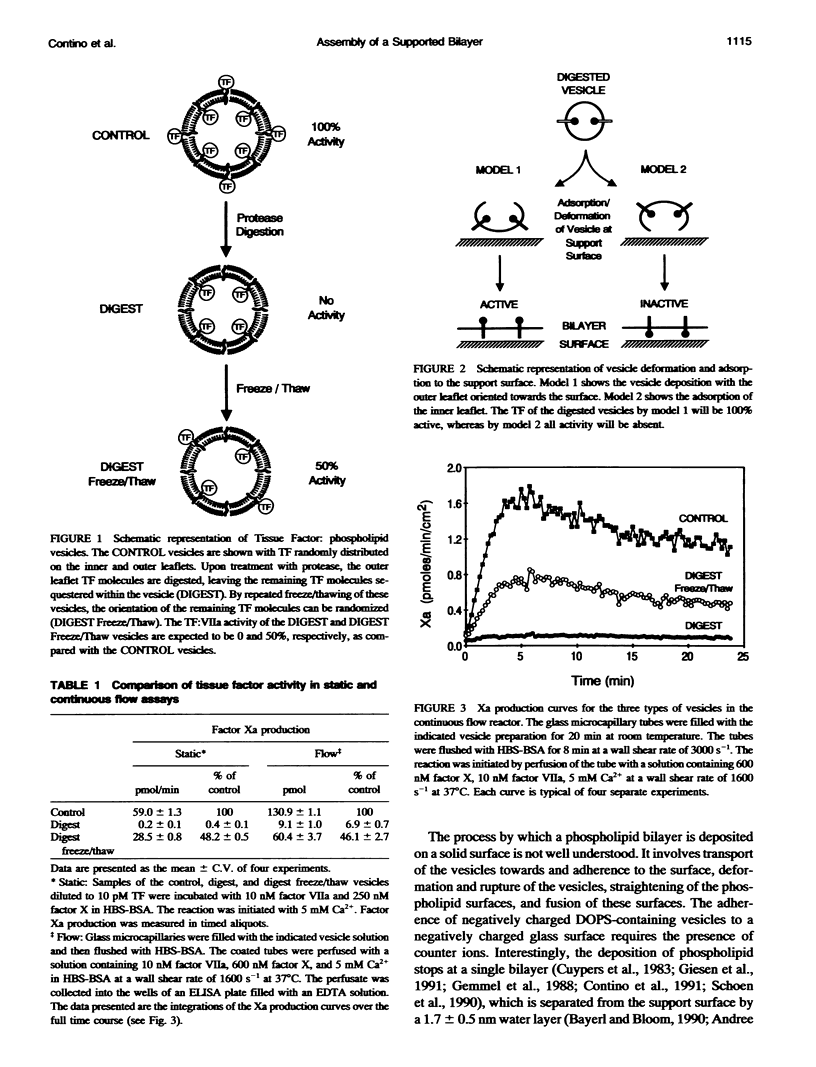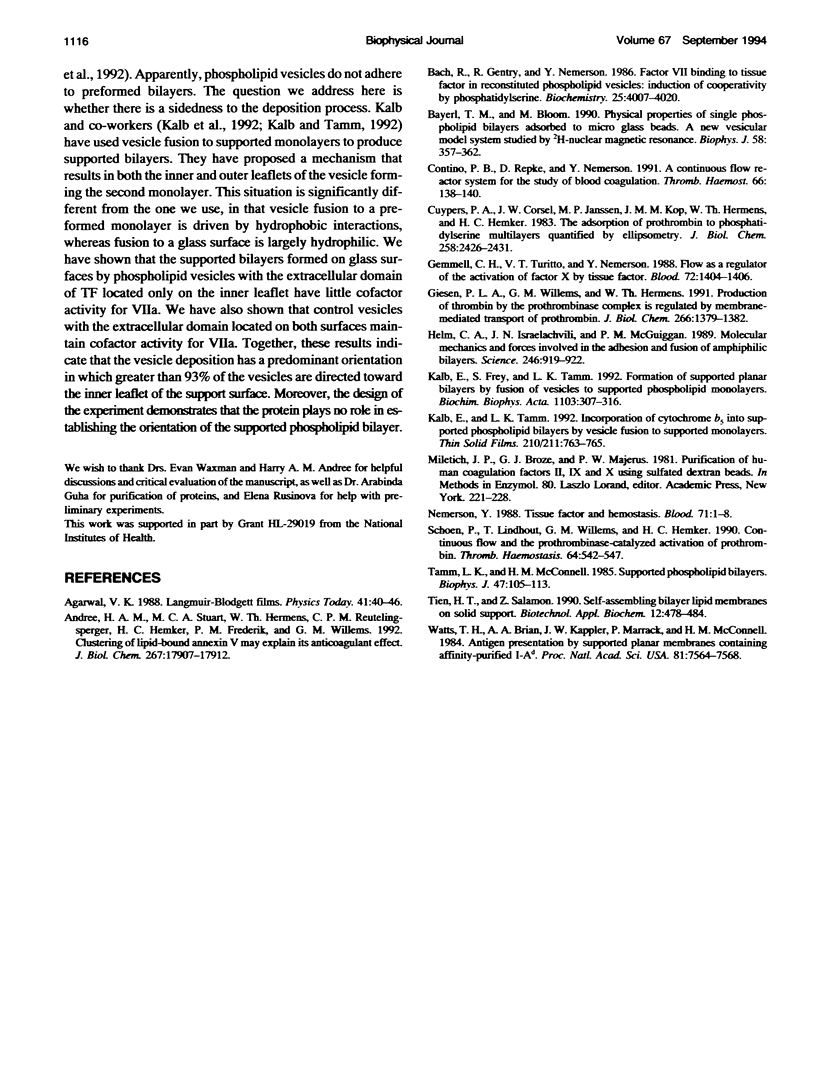Abstract
Planar-supported phospholipid bilayers formed by the adsorption of vesicles are increasingly used in the investigation of lipid-dependent reactions. We have studied the way in which these bilayers are formed with phospholipid vesicles containing the transmembrane protein Tissue Factor (TF). TF complexed with the serine protease, factor VIIa, is the primary initiator of blood coagulation by way of activation of the zymogen factor X. TF has been shown to orient randomly on the inner and outer leaflets of vesicles. We used proteolytic digestion to produce vesicles in which the extracellular domain of TF is located on the inner leaflet. These vesicles show no cofactor activity for factor VIIa as a result of the inability of the extracellular domain of TF to bind VIIa. After freeze/thawing, 50% of the cofactor activity was regained, indicating reorientation of the sequestered, inner leaflet TF. Adsorption of these vesicles to the inner surface of glass microcapillaries results in a continuous phospholipid bilayer. The microcapillaries were perfused with a solution of factors VIIa and X, and the effluent was monitored for factor Xa production, a sensitive measure of the activity of the TF-VIIa complex. For coatings produced with the digested vesicles, minimal TF-VIIa activity was observed, showing that the supported bilayer preserves the orientation of the leaflets in the vesicles, i.e., the outer leaflet of the vesicles forms the outer leaflet of the supported bilayer.
Full text
PDF



Selected References
These references are in PubMed. This may not be the complete list of references from this article.
- Andree H. A., Stuart M. C., Hermens W. T., Reutelingsperger C. P., Hemker H. C., Frederik P. M., Willems G. M. Clustering of lipid-bound annexin V may explain its anticoagulant effect. J Biol Chem. 1992 Sep 5;267(25):17907–17912. [PubMed] [Google Scholar]
- Bach R., Gentry R., Nemerson Y. Factor VII binding to tissue factor in reconstituted phospholipid vesicles: induction of cooperativity by phosphatidylserine. Biochemistry. 1986 Jul 15;25(14):4007–4020. doi: 10.1021/bi00362a005. [DOI] [PubMed] [Google Scholar]
- Bayerl T. M., Bloom M. Physical properties of single phospholipid bilayers adsorbed to micro glass beads. A new vesicular model system studied by 2H-nuclear magnetic resonance. Biophys J. 1990 Aug;58(2):357–362. doi: 10.1016/S0006-3495(90)82382-1. [DOI] [PMC free article] [PubMed] [Google Scholar]
- Contino P., Repke D., Nemerson Y. A continuous flow reactor system for the study of blood coagulation. Thromb Haemost. 1991 Jul 12;66(1):138–140. [PubMed] [Google Scholar]
- Cuypers P. A., Corsel J. W., Janssen M. P., Kop J. M., Hermens W. T., Hemker H. C. The adsorption of prothrombin to phosphatidylserine multilayers quantitated by ellipsometry. J Biol Chem. 1983 Feb 25;258(4):2426–2431. [PubMed] [Google Scholar]
- Gemmell C. H., Turitto V. T., Nemerson Y. Flow as a regulator of the activation of factor X by tissue factor. Blood. 1988 Oct;72(4):1404–1406. [PubMed] [Google Scholar]
- Giesen P. L., Willems G. M., Hermens W. T. Production of thrombin by the prothrombinase complex is regulated by membrane-mediated transport of prothrombin. J Biol Chem. 1991 Jan 25;266(3):1379–1382. [PubMed] [Google Scholar]
- Helm C. A., Israelachvili J. N., McGuiggan P. M. Molecular mechanisms and forces involved in the adhesion and fusion of amphiphilic bilayers. Science. 1989 Nov 17;246(4932):919–922. doi: 10.1126/science.2814514. [DOI] [PubMed] [Google Scholar]
- Kalb E., Frey S., Tamm L. K. Formation of supported planar bilayers by fusion of vesicles to supported phospholipid monolayers. Biochim Biophys Acta. 1992 Jan 31;1103(2):307–316. doi: 10.1016/0005-2736(92)90101-q. [DOI] [PubMed] [Google Scholar]
- Nemerson Y. Tissue factor and hemostasis. Blood. 1988 Jan;71(1):1–8. [PubMed] [Google Scholar]
- Schoen P., Lindhout T., Willems G., Hemker H. C. Continuous flow and the prothrombinase-catalyzed activation of prothrombin. Thromb Haemost. 1990 Dec 28;64(4):542–547. [PubMed] [Google Scholar]
- Tamm L. K., McConnell H. M. Supported phospholipid bilayers. Biophys J. 1985 Jan;47(1):105–113. doi: 10.1016/S0006-3495(85)83882-0. [DOI] [PMC free article] [PubMed] [Google Scholar]
- Tien H. T., Salamon Z. Self-assembling bilayer lipid membranes on solid support. Biotechnol Appl Biochem. 1990 Oct;12(5):478–484. [PubMed] [Google Scholar]
- Watts T. H., Brian A. A., Kappler J. W., Marrack P., McConnell H. M. Antigen presentation by supported planar membranes containing affinity-purified I-Ad. Proc Natl Acad Sci U S A. 1984 Dec;81(23):7564–7568. doi: 10.1073/pnas.81.23.7564. [DOI] [PMC free article] [PubMed] [Google Scholar]


